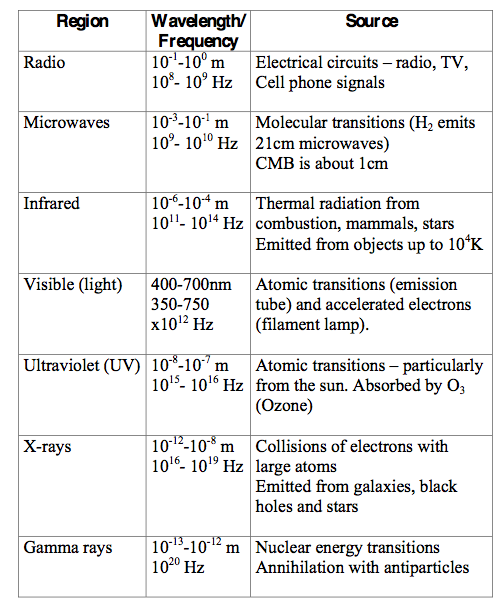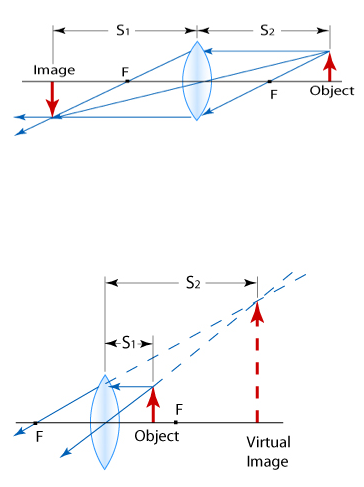Cards In This Set
| Front | Back |
|
G.1.1 Outline the nature of electromagnetic waves.
|
Consider an
electric charge oscillating about a fixed position.
It produces a
varying electric field
It produces a
varying magnetic field (a moving charge is similar to a
current)
The two fields
are perpendicular to each other
|
|
G.1.2 Describe the different regions of the
electromagnetic spectrum.
|
 See Image for table. Students should know the order of magnitude of the frequencies for the different regions, and should also be able to identify a possible source of the radiation in each region. |
|
G.1.3 Describe the dispersion of EM Waves
|
Light passing
from one medium to another is refracted.
Degree of refraction (refractive index)
depends on wavelength
The differential refraction is called
dispersion.
|
|
G.1.4 Describe
the dispersion of EM Waves in terms of the frequency dependence of refractive
index on wavelength.
|
The index of refaction depends on wavelength
and is smaller for, for example, red light. White light entering a prism splits
into the clours of the rainbow in a phenomenon called dispersion. The index of
refraction for red light is smaller than that for blue and so a red ray has a
larger angle of refraction.
|
|
G.1.5 Distinguish
between transmission, absorption and scattering of radiation.
|
Transmission: EM radiation
passing from one medium to another. Partially reflected Partially refracted
Absorption: If the energy of the EM
radiation matches the energy difference between electron levels, photons will
be absorbed.
Scattering of radiation: EM radiation
interacts with molecules causing the electrons to oscillate producing radiation
in all directions. Does not alter the incident radiation in any other way.
|
|
G.1.6 Discuss examples of the transmission,
absorption and scattering of EM radiation.
|
-
the effect of the Earth’s atmosphere on incident EM
radiation.
-
simple explanations for the blue colour of the sky, red
sunsets or sunrises,
-
the effect of the ozone layers
-
effect of increased CO2 in the atmosphere.
|
|
G.1.7 Explain the terms monochromatic and
coherent.
|
·
monochromatic--light with a single wavelength
·
coherent--light made up of waves that are in phase with each other
|
|
G.1.8 Identify laser light as a source of
coherent light.
|
Laser is a source of coherent light.
|
|
G.1.9 Outline the mechanism for the production
of laser light.
|
Basically, atoms are population
inverted, therefore, more exist in the higher-energy level, thereby emitting
light of a certain frequency i.e. laser. Normally electrons occupy lowest available energy levels. To
produce laser light a large number of electrons are promoted to a higher energy
level
|
|
G.1.10 Outline
an application of the use of a laser.
|
• medical applications
• communications
• technology (bar-code scanners, laser disks)
• industry (surveying, welding and machining metals, drilling
tiny holes in metals)
• production of CDs
• reading and writing CDs, DVDs, etc.
|
|
G.2.1 Define the terms principal axis, focal
point, focal length and linear magnification as applied to a converging (convex) lens.
|
1. *Principal axis Line through the focal point
of a lens and the center of the lens.
2. *Focal point Location on the principal axis where parallel
light rays converge after passing through the lens.
3. *Focal length Distance between the focal
point and the center of the lens.
4. *Linear magnification The ratio of the
height of the image to the height of the object.
|
|
G.2.2 Define the power of a convex lens and
the dioptre.
|
1. *Power of a converging lens The reciprocal of
the focal length of the lens
2. *Dioptre The unit of power for a converging
lens: 1 dioptre = 1 m-1
|
|
G.2.3 Define linear magnification.
|
1. *Linear magnification The ratio of the
height of the image to the height of the object.
|
|
G.2.4 Construct ray diagrams to locate the
image formed by a convex lens.
|
 See image. |
|
G.2.5 Distinguish between a real image and a
virtual image.
|
1. *Real image Image formed when light rays actually
converge on a location and can be projected onto a screen.
2. *Virtual image Image formed by light rays
that only appear to converge on a location and cannot be projected onto a
screen.
|



